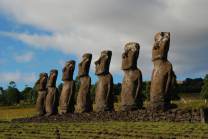
Easter Island
Easter Island (Rapa Nui: Rapa Nui, Spanish: Isla de Pascua) is a Chilean island in the southeastern Pacific Ocean, at the southeasternmost point of the Polynesian Triangle. Easter Island is famous for its 887 extant monumental statues, called moai, created by the early Rapa Nui people. In 1995, UNESCO named Easter Island a World Heritage Site, with much of the island protected within Rapa Nui National Park.
Polynesian people most likely settled on Easter Island sometime between 700 and 1100 CE, and created a thriving and industrious culture as evidenced by the island's numerous enormous stone moai and other artefacts. However, human activity, the introduction of the Polynesian rat and overpopulation led to gradual deforestation and extinction of natural resources which severely weakened the Rapa Nui civilization. By the time of European arrival in 1722, the island's population had dropped to 2,000–3,000 from an estimated high of approximately 15,000 just a century earlier. European diseases and Peruvian slave raiding in the 1860s further reduced the Rapa Nui population, to a low of only 111 inhabitants in 1877.
Easter Island is one of the most remote inhabited islands in the world. The nearest inhabited land (around 50 residents in 2013) is Pitcairn Island, 2,075 kilometres (1,289 mi) away; the nearest town with a population over 500 is Rikitea, on the island of Mangareva, 2,606 km (1,619 mi) away; the nearest continental point lies just in central Chile, 3,512 kilometres (2,182 mi) away.
Easter Island is a special territory of Chile that was annexed in 1888....










